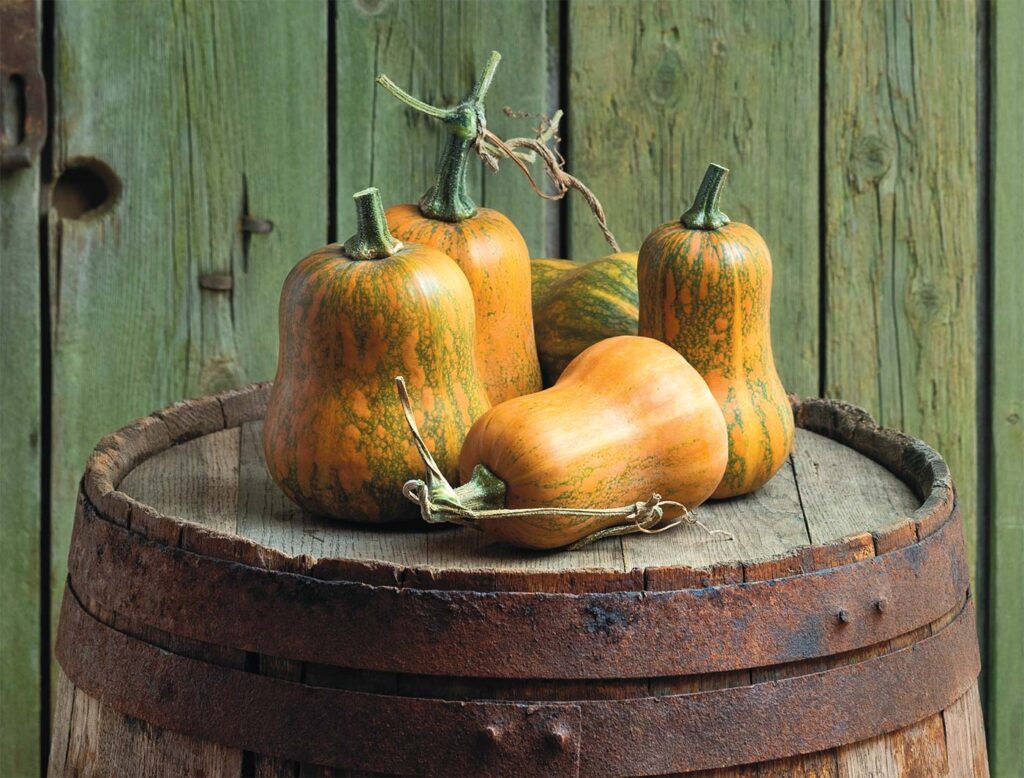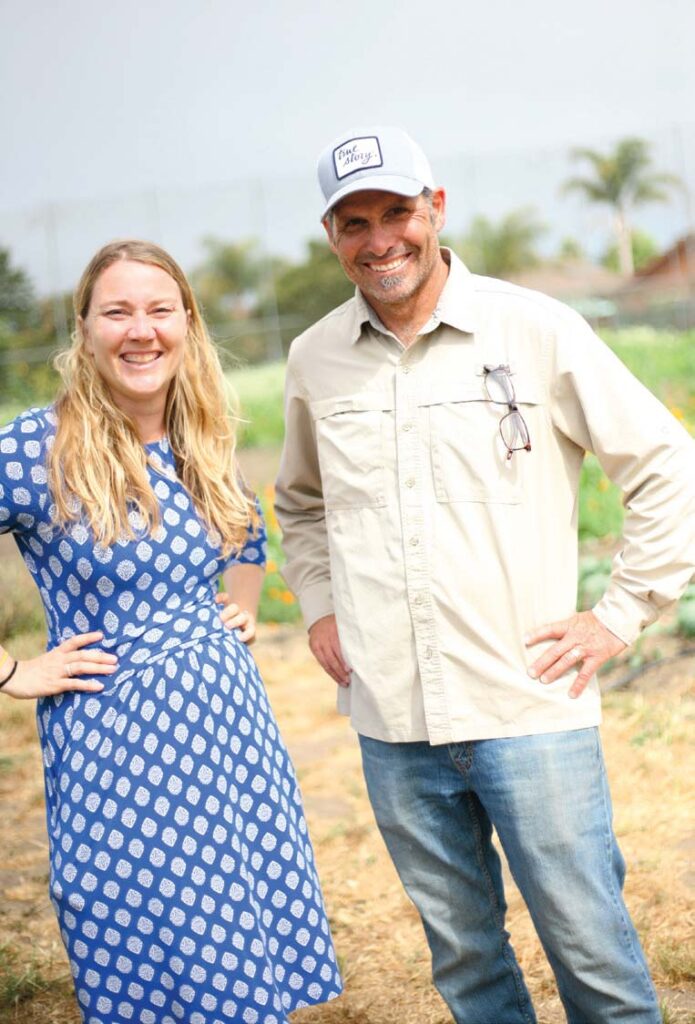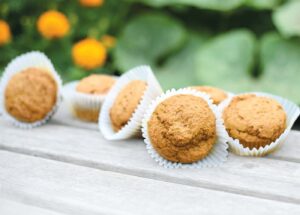
Why many are obsessed with this fleeting—and cute—gourd (and you should be too)
PHOTOGRAPHY BY KELLY ROSE EVANS
That there could be anything better to replace my beloved butternut was unimaginable!
When I was a broke college student at Cal Poly majoring in crop science, I would buy butternut squash and roast them to bring to school for lunch.
Winter squash are cheap, nutritious and a good way to fill up on a student’s budget.
I remember fellow ag students looking at me as if I was an alien as I happily ate my winter squash while they stood in line for their daily tri-tip sandwich, devoid of vegetables. I found it amusing that I was eating what we were studying but was thought of as the weird one.
I love butternut for its versatility and flavor. To think that there could be anything better to replace my beloved butternut was unimaginable! Flash forward a few decades—and some plant breeding improvements— to the release of the honeynut, a lovechild of the butternut and buttercup squash.
The goal was to select for a smaller, more manageable squash with a more intriguing appearance, one that was also sweeter than a butternut.
HISTORY OF THE HONEYNUT
This idea started in the 1980s with a Cornell University professor named Richard Robinson, who crossed a honeynut with a buttercup looking for a tastier version. In 2006 another professor and plant breeder from Cornell, Michael Mazourek, decided to continue his work on breeding the perfect squash in collaboration with Dan Barber, the chef and co-owner of Blue Hill restaurant at Stone Barns Farm, a research and educational farm in New York’s Hudson Valley.
After multiple years and seed selection from cross-pollination, the prized honeynut was born. In 2015 the seeds were available to purchase commercially. If you thought butternut was sweet and tasty and have yet to try a honeynut, you are about to have your mind blown. They are dark beige with green mottling, weigh about 1 to 1.5 pounds and are much sweeter than a butternut. Honeynut flesh is dense with a creamy consistency and a fine texture. They have a well-rounded, rich and complex flavor with malty, nutty undertones.
Honeynut also fill the need for a more personal-sized, flavorful squash. Shoppers are concerned with wasting food, and farmers are happy to have options besides giant squash that are a hard sell to those types of customers. If you want to find the honeynut squash, you must locate them at the farmers market; I have yet to see them available in mainstream grocery stores. I have been growing honeynut for many years at Serendipity Farms, where it’s a favorite among customers and the first winter squash to sell out alongside delicata—another deliciously sweet winter squash with a chewy edible skin.
Like all winter squash, honeynuts are available in the fall and store until late winter—earlier than their parent butternut. They can start to lose their water content when they are past their prime, so look for firm, heavy squash with no blemishes or wrinkles.
Row 7 Seed Company, directed by chef Barber, grows mainly for flavor rather than for high yields, germination rates and crop uniformity. Row 7 also does not patent their varieties, allowing future plant breeders to improve on the existing varieties.
They now offer an improvement to the honeynut called the 898 squash, which is an even smaller version, measuring only 4 to 6 inches and fitting in the palm of your hand. The 898 squash was also bred to improve flavor further and address the short shelf life that the honeynut has.
PREPARING HONEYNUT
Both the honeynut and 898 are best prepared by cutting them in half, coating the flesh with a neutral oil and roasting. Roasting caramelizes the flesh, bringing out the best flavor. For a nutritious breakfast I often eat a honeynut with soft-boiled ramen egg on top.
There is no need for brown sugar or maple syrup; these squash are sweet enough on their own. Since they are personal size, I love using them as a side dish: After they are cooked, I fill them with a mixture of wild rice, cooked crimini mushrooms, toasted walnuts, fresh herbs like thyme and sage, and dried cherries or cranberries.
Bitter greens go well with sweet squash; try a radicchio-and-kale-based salad with roasted chunks of honeynut on top, plus goat cheese and toasted pecans and some pomegranate seeds with a nice olive oil and Champagne vinaigrette.
Kelsey Perusse and Geoff Palla bring a collective mega ton of experience around cultivating growth in young minds and organic plants alike.

CULTIVATING HONEYNUT (AND KIDS’ CONNECTION TO THEIR FOOD)
Live Oak School District in Santa Cruz is growing its own winter squash, among other crops, at the old baseball field at 799 Paget Avenue adjacent to the Del Mar High School campus.
Geoff Palla, former garden manager and senior teacher at the famous Edible Schoolyard in Berkeley for 13 years, has been hired as the school farmer and is cultivating one acre for the students thanks to funding from the Child Nutrition Program.
Currently, broccoli, carrots and “three sisters” plantings of corn, beans and squash are being grown, as well as several types of winter squash that the school plans to incorporate into its from-scratch school lunches.
Winter squash varieties include honeynut and butternut, pink banana, delicata, red kuri and musquée di provence.
The school district’s lunch program, run by Food Service Director Kelsey Perusse, also purchases squash, among other items, from the Santa Cruz Community Farmers Market, which holds a market every Sunday just a few blocks away from the school.
It’s a win-win situation for both the kids and the farmers.
Currently there is a Food Lab program where kids in fifth through 12th grades help cook healthy breakfast items and lunch through an elective class for high-school students and an after-school elective for elementary schoolers.
Winter squash gets incorporated in various ways along the lunch line, including housemade red kuri squash biscuits, roasted delicata squash and butternut squash lasagna.
Perusse says one of the goals is to let kids experience vegetables in different ways, including being the star of the main dish, adding that when kids see produce grown they eat it more often, because they get a deeper connection to it.
The Food Lab and farm programs are funded under Nutrition Services, and have received three rounds of funding to be better equipped to cook from scratch. Live Oak School District has big dreams for this program and is looking to fund-raise to leverage its benefit with more in-depth farm-to-school programming experiences like building more farm infrastructure, developing curriculum and hiring a farm educator to teach kids during the school year on the farm as well as run a farm summer camp in 2026. On Oct. 25, the school will host a Pumpkin and Pancake donation-based event from 9am to noon that is family focused and free for kids at 799 Paget Ave., Santa Cruz. Donations will help fund the program’s big plans for kids to connect to their food.
To donate or otherwise join this endeavor, check out liveoaksdnutrition on Instagram. Here’s hoping that with the help of the Food Lab, kids will be more familiar with winter squash and its health benefits so that eating one for breakfast won’t seem as weird as it did when I was in college.

About the author
Jamie Collins is the owner of Serendipity Farms and has been growing organic row crops at the mouth of Carmel Valley since 2001. She distributes her produce through a CSA, u-picks and farmers’ markets.
- Jamie Collinshttps://www.ediblemontereybay.com/author/jcollins/
- Jamie Collinshttps://www.ediblemontereybay.com/author/jcollins/
- Jamie Collinshttps://www.ediblemontereybay.com/author/jcollins/
- Jamie Collinshttps://www.ediblemontereybay.com/author/jcollins/



